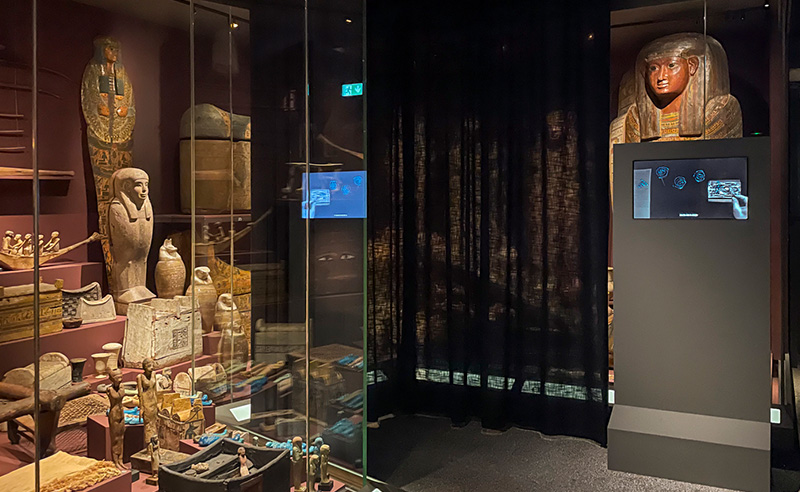What Does It Mean to Care for Our Ancient Egyptian Dead?
Long before debates about statues, there are the people themselves: the ancient Egyptians taken from their tombs, unwrapped, and displayed. Their story asks us what care and dignity truly mean.

What does it mean to care for the ancient dead? It sounds like a straightforward ethical question. Afterall, last year’s debates over redevelopment in areas containing historic cemeteries and burial sites in Cairo showed how contested such issues can be when they concern our departed. But in the world of archaeology, museums, and international heritage, the same question has been avoided for decades. The bodies of ancient Egyptians have been handled, transported, scanned, unwrapped, borrowed, dissected, dismembered and displayed for so long that the practice has come to feel standard. Their removal from tombs is usually discussed in terms of “preservation” or “research,” not in terms of family, grief, or rights.
Sara Sallam, a multidisciplinary artist who grew up in Cairo and now works in the Netherlands, keeps circling back to one question: when did all of this start feeling normal? “The ancient Egyptians were real people who built a civilization deeply connected to their land. The way they are displayed today breaks the bonds and beliefs they cared for in life and in death," Sallam tells CairoScene.
For more than a decade, Sallam has built a body of work that pushes colonial and even local museums to confront a blind spot that sits at the center of their authority. Her installations, books, and moving image works return again and again to the same set of problems albeit each approached from a different emotional standpoint: displacement, fractured families, the loss of funerary context of ancient Egyptian heritage, and the emotional distance that exists between Egyptians today and the ancestors whose bodies now sit in vitrines across Europe and America.
In ‘Egypt Outside of Egypt’, Sallam maps this distance by retracing Egypt’s past in cities that once claimed it. Instead of showing readers where to eat or shop, her flipped handbook leads them through Paris (in the first volume) and London (in the second volume), stopping at monuments and plaques that celebrate imperial victories.
“At each stop, European landmarks are paired with fragments of Napoleonic writing or British accounts that justified taking Egyptian antiquities in the first place,” Sallam explains. The book series offers counter-tours: you start in Europe, but you keep bumping into Egypt everywhere. What’s missing, bodies, objects, histories, becomes the real map. Through these walks, Sallam makes the European cities speak about what they try to bury.
Sara Sallam presents a structural argument that challenges Western narrative and suggests that museums are caretakers of objects, but rarely of people. Especially when the things they hold are human remains, the gap becomes impossible to ignore. Her work brings triggers a question museums always avoid: the emotional and ethical dimension of looking at the dead, and who owns our gaze.
Why Ancient Egypt Became a Western Obsession “Ancient Egypt became part of the expanded history of the West. In museums, civilizations are arranged to form a timeline that begins with Ancient Egypt and ends with Western achievements,” says Sallam, “The fascination with death and the process of mummification is another part of it and definitely played a big role.”
For centuries, the West has been transfixed by the promise of Egyptian eternity, a fascination that exploded in Victorian Britain with mummy-unwrapping parties and mummy powders sold as medicine. What began as curiosity bred collection: European and American museums amassed vast quantities of Egyptian mummies through diplomats, dealers, and colonial excavations. With little legislation in place and the “50/50” partage system that allowed foreign missions to keep half of what they unearthed, the mummy trade exploded and became normal and global.
Museums work nowadays on two implied principles: that objects, including so much of the dead of ancient Egypt, must be preserved forever. And that everything, including the same dead of ancient Egypt, must be open to the public. “Through our encounter with the ancient Egyptians in museums, we have learned to see their remains through the eyes of an archaeologist studying artefacts, or even sometimes through the eyes of a medical examiner looking at their X-rays. That way of seeing became normal,” Sallam reflects.
When the object is a pot, a statue, or a fragment of papyrus, the logic adds up. But when the “object” is a human being, or a family burial assemblage, the logic breaks down.
“Under the pretext of preservation, museums tend to hold the collection captive, with their focus primarily being on its materiality and physical well-being.” And once something is framed as “preservation,” questions about belonging, consent, or dignity are sidelined. “Funerary objects were meant to stay as an assemblage in a tomb. They were carefully made for a real person’s spiritual well-being and not for our curious eyes staring at a display case.”
The Case of the Mummified Child in Stockholm One of Sallam’s best-known works, 'You Know My Name', emerged from her encounter with a small mummified child displayed at the Medelhavsmuseet in Stockholm. The museum presents him as a scientific specimen: partially unwrapped, exposed, and on display near a digital autopsy table where visitors can virtually peel off his wrappings. “The assumptions underlying this display were very disturbing. Most of the research conducted on this child over the years has been about his medical condition,” she says. “CT scans, X-rays. We don’t know his name, but we insist on knowing how he died.”
Sallam built an installation that adds an act of choice where she covered with curtains the vitrine where this child and another mummified woman are on display.
“Visitors must now decide: Do I want to see his body? And if I choose to see it, do I want to close the curtain again afterward and give him privacy?”
This simple shift reframes the encounter and turns viewing into responsibility. The viewer now is no longer a passive consumer of heritage; they must confront the fact that they are looking at a real child, not a museum specimen.
Her installation also included an audio-visual narrative, an emotionally laden layer where she imagines the child speaking to his mother, with his mother answering through ancient funerary prayers. Sung by Sallam’s mother, these ancient prayers were once whispered while wrapping the ancient dead to protect them for the afterlife.
The Sekhmet Statues:
When Protection Fails
Sallam’s project, 'The Sun Weeps for the Land and Calls from the Garden of Stones', takes the conversation beyond individual bodies. It focuses on the Sekhmet statues, hundreds of lion-headed goddesses carved during the reign of Amenhotep III. These statues originally formed protective circles around the king. Their power came from repetition, ritual, and proximity and their colonial removal destroys that purpose.
“They were goddesses meant to protect, but once they were taken from their land and scattered, their circle was broken. They failed in their duty, and that failure is emotional,” Sallam explains. One section of the project stands out which is where Sallam creates cyanotypes of the statues and performs a ritual inspired by the Opening of the Mouth ceremony. She “activates” the prints and then carries them to Aswan, where she buries them in the quarries where the statues were originally carved.
Reversing displacement might be impossible now the acknowledgement that objects and bodies once had roles tied to specific places, rituals, and relationships is more essential that any previous time. Without those, something essential is lost.
Taperet and the Limits of What Can Be Known:
Sallam’s newest project returns to the Mediterranean Museum in Stockholm, focusing on the sarcophagus of a woman named Taperet and her family. Her tomb objects were removed by the Swedish-Norwegian consul Giovanni Anastasi in the 19th century, and later sold or gifted across Europe. “It’s about the destruction of a family tomb, the separation of an ancient family through sales and dispersion.” Today, pieces believed to belong to the same tomb are held in Sweden, Leiden, London, and Paris.
“We cannot know where the bodies are or if they survived. And while the Sekhmet project revolves around failure, statues failing to protect the king, the Taperet project revolves around impossibility of union.” Sallam imagines Taperet speaking to her husband and son, repositioning the family as a relational unit rather than a set of separated artefacts.
The Debate Museums Avoid:
The questions Sallam raises are not new. They echo long-standing debates about repatriation, restitution, and heritage ownership. But she approaches them from a different angle. Instead of asking whether Egypt “deserves” to have objects back, she asks whether the people inside those objects deserve dignity. “Before we talk about Nefertiti or famous statues,” she says, “we should talk about the human remains. We should first ask for the return of our ancestors and in tandem in parallel we should be rethinking. What do we do with our ancestors?”
This argument is difficult for museums to engage with because it moves the conversation from institutional stewardship to moral responsibility, and also raises a question few museums want to discuss publicly:
Is it appropriate to display human remains at all? Sallam does not push for a universal ban, but she calls a shift in perspective.“If we connect emotionally,” she says, “we will automatically not want to see them displayed like this.”
On Decolonial Museums:When I asked Sallam whether a decolonial museum could ever exist she said yes right away, “but it must rethink everything, it would rely less on glass and more on human senses. Not everything must be preserved forever; some things are meant to fade. And it must finally ask: who owns, who accesses, who consents?”
One idea is repeated throughout Sallam's work: protection.
Who protects the dead? Who protects their stories? Who protects their bodies from invasive scientific practices? Who protects their families from being split across continents? For Sallam, protection must be relational.
- Previous Article Museum of Natural History Abu Dhabi Opens With Meteors
- Next Article جهاد يطلق ألبوم “PLATA O PLOMO" معيدًا الراب الليبي إلى الكلاسيكية وال
Trending This Week
-
Nov 17, 2025



























